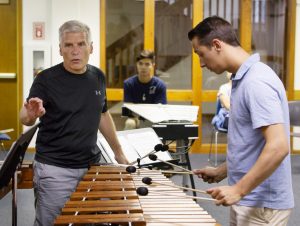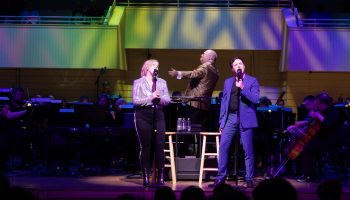
Though there’s been no shortage of chamber music at Chautauqua this summer, one recital in particular will offer a rare musical experience: an ensemble made entirely of percussionists.
At 3:30 p.m. today, August 2, in Elizabeth S. Lenna Hall, School of Music guest percussion faculty Michael Burritt will perform in a program he put together with a student percussion ensemble made up of Instrumental Program students Emma Gierszal, Alvin Macasero, Michael Metz, Zachary Strong and Ajay Wadhwani. Altogether, they will play more than 20 percussion instruments throughout the recital, which will feature four contemporary pieces — three of which were written within the past five years, including one written by Burritt himself. The students will play the first three pieces, then Burritt will join them for the last.
All of the music falls within the realm of postminimalism, a type of music that takes the repetitive rhythmic ideas of minimalism and expands upon them in dynamic ways.
The first piece, by Drew Worden, is called “Black Smoke, White Smoke.” Worden wrote and premiered the piece while a student at Chautauqua several years ago. It uses both traditional and unique percussion instruments, from drums to wooden planks.
“It’s kind of a fun piece,” Burritt said. “It’s a quintet, so (it) can keep everyone busy, and there’s a lot of different sounds.”
Following this will be “Death Wish” by Gemma Peacocke, played by four people on two marimbas; the piece is a commentary on sexual assault and its lasting effects. Burritt chose this piece as part of a conscious effort to have a woman composer on the program, as well as for its artistic merit.
“It’s a beautiful piece,” Burritt said. “It’s very minimalistic and very melodic and harmonic in nature.”
Next on the program is a set of three movements from Philip Glass’ “Águas da Amazônia” (Waters of the Amazon). Each movement is named after a river in Brazil: “Madeira River,” “Xingu River” and “Amazon River.” Originally written as an opera for an ensemble using traditional, handmade Brazilian instruments, it was transcribed to be performed by a percussion quartet. The piece uses marimba, vibraphone, synthesizer, desk bells and melodica.
“It’s kind of an interesting sound world that is created through the Philip Glass pieces,” Burritt said. “They’re very, what we call, consonant pieces. … The harmonic language is going to be very familiar to people.”
These pieces have only ever been played by one other group; this will be the first time a student group will perform them.
Lastly, Burritt will join the students for the performance of “White Pines,” which is the second movement of one of his larger pieces, “The Home Trilogy.” The title is a reference to snow-covered pine trees in the winter; it is very energetic, with marimba somewhat mimicking the effect of a strumming guitar, and frequent use of hand drums.
“It’s supposed to create a lot of energy, both from the rhythmic nature of what I wrote (and) also from the colors of the ensemble,” Burritt said. “It’s almost like a soaring burst of energy for about 10 minutes.”
Percussionists do not often have the chance to dominate the stage. When playing in the orchestra, they are usually positioned in the back and spend a lot of time waiting for their parts to come around. In a recital like this one, however, the percussionists are the main event, giving them an opportunity to perform in sustained ways, rather than in short bursts. It is a test of their focus and technical mastery.
“You’re responsible on a whole other level for carrying the musical intensity or musical narrative for the whole piece,” Burritt said. “You’re in it more, so that in and of itself creates a different challenge and a different experience — a good one.”
It is likely a new experience for the audience, too; unlike most other chamber ensembles, percussion groups are steeped in strong rhythmic energy and the ability to switch often from instrument to instrument. The nature of percussion instrument sounds is an entirely different aural realm than traditional chamber music groups centered on strings and woodwinds, as well.
“(Percussion) can be very viscerally impactful,” Burritt said. “Also the colors are very beautiful, so the timbres or sound colors will also probably be a new world for (the audience). And I think visually, percussion is very stimulating to watch because there’s a lot of movement.”
For Burritt, it is a great chance to work with students, an experience he always finds invigorating and inspiring.
“I love working with students because they have a unique energy, and they are the future of what we do,” Burritt said.




